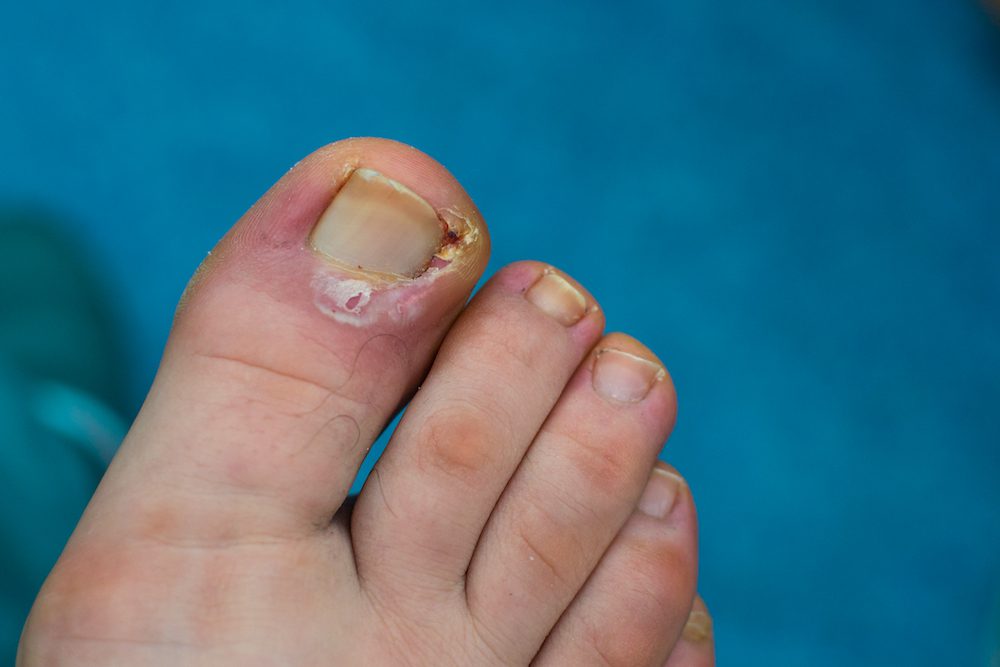Ingrown toenails occur when the nail edge grows into the surrounding skin, typically on the big toe. Redness, swelling, tenderness, and a small amount of drainage may appear at the nail margin. While mild cases are manageable at home with steady care, persistent pain, spreading redness, or signs of infection call for prompt evaluation. Here are some tips and tricks to manage them:
Avoid Cutting Toenails Too Short
Leave a small margin beyond the fingertip-like end of the toe, rather than rounding deep into the corners. Trimming too aggressively thins support at the edges, and the soft tissue may ride over the nail, which increases the risk of the edge digging in. Use straight cuts across the nail plate; then lightly file rough edges so socks do not snag. If a corner feels sharp, avoid digging with scissors or a metal tool.
Use clean, sharp clippers reserved for toenails. Thick nails may require a larger, straight-blade cutter, and a brief soak before trimming helps to soften them. Clip after a shower, dry the feet, and inspect with good light. If the nail border is already tender, pause trimming near that area and focus on reducing pressure instead. A small wedge of cotton under the edge might lift the nail slightly, but it risks irritation if packed too tightly or left wet. When in doubt, keep the edge smooth and untouched until the tissue calms down.
Wear Shoes That Fit
Toes need room to lie flat, and not enough room can lead to ingrown toenails. A tight shoe compresses the nail fold, and a shallow fit can run against the nail tip. A short length can also cause the front of the shoe to rub against the toenail during walking. Aim for about a thumb’s width of space beyond the longest toe, and check the width so the upper does not pinch the sides.
- Features to look for include a wide, rounded toe box, adjustable lacing or straps, breathable uppers, and a cushioned yet stable sole.
- Rotate pairs to let shoes dry, replace worn-out insoles, and wear moisture-wicking socks to reduce friction.
Heels that load the forefoot, narrow dress shoes, and cleats with stiff, tapered fronts raise pressure at the nail edge.
Soak Feet in Water
Although brief, a soak softens the skin around the nail, reduces surface debris, and supports gentle cleaning. Rinse with warm water once or twice daily. Using Epsom salt is helpful, as it aids in softening and hygiene. After soaking, rinse, pat dry carefully, and apply a thin layer of plain petroleum jelly or a light, fragrance-free ointment to the irritated margin. Then cover with a small, breathable bandage. Do not attempt to cut deeper after soaking, as softened tissues are more prone to nicking, and even tiny cuts can lead to increased irritation. Keep the bandage clean and change it if it gets wet.
Manage Ingrown Toenails Professionally
Home steps help, yet recurring pain, moderate swelling, or any sign of infection warrants professional care. A podiatrist assesses nail shape, surrounding tissue, shoe wear patterns, and gait. Treatments may include gentle edge-lifting, removal of a problematic spicule, topical care, or partial nail procedures that target the ingrown segment while preserving a natural look. Guidance on nail length, trimming tools, and footwear fit can help reduce repeated irritation in daily life. If you are dealing with a stubborn ingrown toenail, schedule an appointment with a qualified foot specialist.


